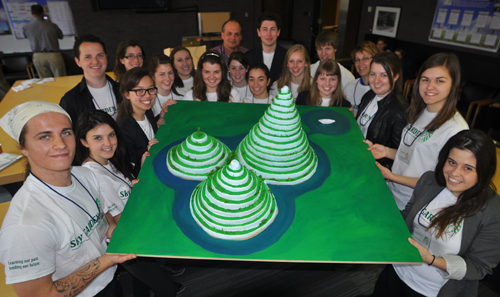
Grow up. That’s the advice of U of G students who say ideas in their vertical farming project might help feed cities with fewer resources, less waste and less space.
For a first-year seminar class this semester, the group designed a “sky garden” – although an initial glance at their futuristic model might suggest a wedding cake or an old-style beehive.
Imagine stacking greenhouses a dozen storeys into the sky. Place the stack in a city lot close to consumers. Use hydroponics or aeroponics to grow fruits and vegetables – and even devote space to raising poultry or fish. Include systems to provide nutrients and green energy and to reuse waste products.
Those are the principles behind controlled environment farming explored by students in this semester’s “Vertical Farming” course taught by Prof. Vern Osborne, Animal and Poultry Science.
“Vertical farms need fast-growing species that don’t take a lot of space and use by-products from other commodities. It’s like an ecosystem,” says Osborne. “It’s bringing engineering and technology, environment, economy and society together.”
Besides challenging students to consider design and production in such a system, he encouraged them to consider marketing, community and social benefits of their sky garden.
For instance, the system might produce food for institutions such as schools, hospitals and community homes. The facility might become a learning centre for people taking courses in cooking and meal preparation or for students studying farming, nutrition and science.
Rather than create a cube-shaped stack of greenhouses, the students designed three domes made of “living glass” (recycled resin and glass) to help catch more sunlight through energy-efficient light guide tubes. They say their spiral buildings would help capture rainwater and allow for interior wind turbines rather than external blades. Air would enter through vents to be cycled through the building.
The largest dome would stand 15 storeys high, with another five storeys underground.
Fruits and vegetables might be cultivated year-round in this controlled environment, says Osborne.
Early this semester, the class toured the U of G Controlled Environment Systems Research Facility in the School of Environmental Sciences. There, researchers study controlled indoor growing for applications ranging from outer space to the greenhouse trade.
The students also visited the rooftop growth chambers and greenhouse on the Science Complex.
As an alternative to land-gobbling farms, says Nicole Wismer, “vertical farms provide food and take advantage of vertical space right in cities. Food is grown in controlled environments, which increases yield because variables such as weather and pests can be eliminated.”
The studio art major says she wants to see more sustainable and less wasteful farming and food production practices in North America.
Vertical farms have yet to catch on. Prototypes were built in 2010 and 2011 in Japan, South Korea, the Netherlands and England; others are planned for the United States.
Funding is the main hurdle, says Wes Chase, a marine and freshwater biology major. Referring to costs of equipment and expertise, he says, “The first couple would be expensive to set up.”
He thinks vertical farms might gain popularity if people learned more about the benefits of supplying local, environmentally sustainable food for growing cities.
Chase plans to work in fish farming one day. That’s one application touted by vertical farming proponents, including Dickson Despommier, a Columbia University professor whose book, The Vertical Farm: Feeding the World in the 21st Century, was published in 2011.
Osborne has been studying related design ideas for housing chickens. He grows cash crops on a (horizontal) 300-acre farm in Rockwood, Ont. He grew up there helping his parents with their former dairy operation before studying animal science at Guelph.
He says that, for all of its futuristic flavour, vertical farming draws on millennia-old farming practices. “It’s not new, it’s 3,000 years old. We’ve taken terrace farming and put controlled environment systems around it.”